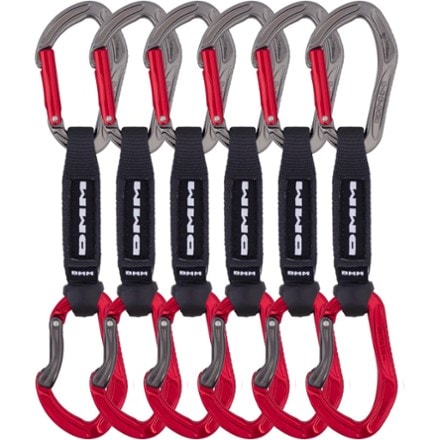Titanium Climbing Hardware
(1 product)- Quickdraws (1)
- DMM (1)
- Bent-gate (1)
- Straight-gate (1)
- Rock Climbing (1)
- 1 to 1.49 (1)
- DMMAlpha Sport Quickdraw - Package of 6$231.00 - $235.00(0)0 reviews
Related Expert Advice articles
What type of belay device is best for you?
- Tubular belay device: Compact, light and easy to use. Lightweight climbers may find them slow for rappelling. Best for gym, sport and multipitch trad climbing.
- Assisted-braking belay device: Easy to control, feed rope smoothly and aid in stopping falls. Heavier and not compatible with certain rope diameters or icy/wet ropes. Best for gym, sport and multipitch trad climbing.
- Figure 8 Belay Device: Efficient and smooth for rappelling, efficiently dissipate heat from friction and work with most rope diameters. Harder to handle. Best for search and rescue, caving and rappelling.
Locking vs. Non-locking
Locking carabiners have gates that can be locked to prevent accidental openings. Use them for belay/rappel devices and critical protection placements. Choose between:
Screw-lock: Requires manual twisting to close.
Auto-locking: Automatically locks when the gate closes.
Non-locking carabiners are lighter, quicker to clip or unclip but can accidentally open. Ideal for racking gear or for quickdraws.
Shape
Asymmetric D: Most common design; lightweight with a large gate for easy clipping. Great for sport and trad climbing.
D shape: Strongest shape, excellent for most kinds of climbing. Ideal for racking trad gear.
Pear shape: Designed for belaying, rappelling and anchor points. Heavier and more expensive.
Oval shape: Smaller gate opening and affordable. Ideal for aid climbing or racking trad gear. Not as strong or light as other shapes.
Gate Types
Straight-gate: Durable and easy to use. Good for various purposes and sport-climbing quickdraws.
Bent-gate: Makes rope clipping easier. Generally used for quickdraws.
Wire-gate: Lightweight, less likely to vibrate open during a fall or freezing shut.
Locking: Most secure; required for use with belay/rappelling devices and critical protection placements.
Read full article: How to Choose Climbing Nuts, Stoppers and Chocks
